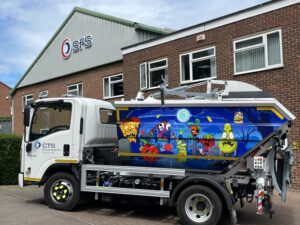The industrial vehicle sector is an inspiring place to be right now. Manufacturers are pushing the pace of product development to harness the latest technologies to bring the vehicles and machinery of the future to market.
These advances have also presented challenges for brands seeking better ways to showcase new products and support services that not only drive revenue, but also engage audiences in a world that has evolved during the pandemic.
Daniel Owen, CEO of The Armstrong Partnership which works with leading commercial and industrial vehicle brands, shares his key considerations for manufacturers exploring ways to enhance product marketing for their current portfolio, and those bringing new products to market.

The benefits of alternative fuels
Across the board we’re seeing more trialling and adoption of alternative fuels for commercial and industrial vehicles, in particular improvements in battery technology for larger vehicles to increase range as well as hydrogen powered engines. What’s important for original equipment manufacturers (OEMs) to grasp is how they visualise and communicate the technology that’s going to be used to power vehicles. They need to be compelling in how they sell the features and benefits to convince fleet owners and municipalities to adopt new technologies ahead of other brands competing in the same space.
Challenger brands
For decades, commercial and industrial vehicle sectors have been dominated by long-standing manufacturers. But much like the automotive sector, with brands such as Tesla and Polestar, we’re seeing emerging challenger brands starting to disrupt the marketplace. Take Arrival, for example, and its concepts for new electric vehicles – which has historically been a stable sector for OEMs. As alternative fuels and associated technologies continue to gather pace – we’ll see more challenger brands emerge, and manufacturers should be prepared for new players and more radical approaches to brand and product marketing.
Isolate unique technology
Leading automotive brands like Audi have built enviable customer loyalty by placing more emphasis on individual technology brands (Quattro, S Tronic) than the overall company brand. This is achieved by drawing attention to certain technologies within vehicles to differentiate a product within the category. This makes the buyer feel like they’re getting more for their money and supports the price point. Commercial vehicle and industrial manufacturers can take inspiration here, instead of trying to compete machine-to-machine with other brands, focus on highlighting the specifics of your technology – giving each element its own identity. This will help to highlight unique features, engage customers and successfully differentiate your brand in the market.
Simplicity is key
We often see overcomplicated model and variation labelling on commercial and industrial vehicles – it does nothing but confuse your customers. By having a simple model and variation labelling system, it makes it easier for customers to understand the hierarchy within your product portfolio. When it comes to selling variations, group these into packs or bolt-ons, for example a comfort pack – offering upgrades to seats, suspension and so on. This is a much simpler way of being able to upsell a group of variations rather than labelling each one individually, which can often lead to an under-specified final product.
Own your space
Whether it’s clean energy, comfort, automation or digitalisation of machinery – think about how your products feed the bigger idea and how your brand can take ownership of this space. This doesn’t mean simply focussing on machine capabilities, but how your brand lives and breathes this brand purpose so that your customers don’t need to think twice when it comes to the manufacturer that excels in a particular space.
Create an emotional connection
Commercial and industrial vehicle marketing can be very technical and function-driven, but brands still need to create an emotional connection with their audience, especially when it comes to growing market share. This is where an experienced creative partner should be able to work with you to convey all the technical highlights of a product or machine while also engaging audiences on an emotional level.
Make life simple for dealers
OEMs that sell through a network of dealers must ensure a steady flow of marketing material that can be dual-branded and deployed easily. Often, this is the part that slips between the cracks – where dealers expect manufacturers to be marketing new products and vice versa. It’s the dealer that should be responsible for selling the vehicle and championing the brand, but manufacturers need to support them by producing marketing collateral centrally that can be adapted, dual-branded and deployed in-market.
The Armstrong Partnership
www.wearearmstrong.com
Sponsored content feature.




